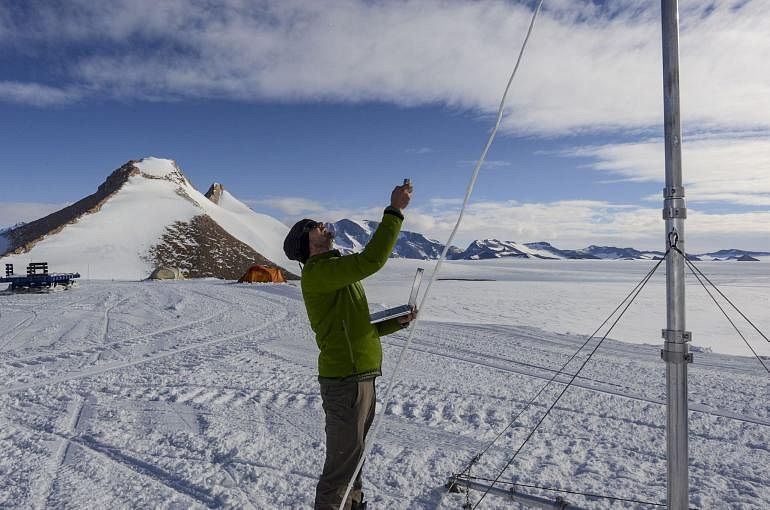Coastlines could experience changes in sea level of over 1.8 metres by the end of 21st century, or so Delft climate researchers believe. In two recent publications they shed new light on Antarctica’s role in climate change.
Antarctica continues to puzzle climate researchers. Polar temperatures over the last several million years have sometimes only been slightly warmer than today. Global mean sea level, however, has been 6 to 9 metres higher during the Last Interglacial. The culprit is believed to be mainly the Antarctic ice sheet.
So what could Antarctica have in store for us? That is what an international group of researchers, amongst whom Riccardo Riva (Faculty of Civil Engineering and Geosciences), tried to find out. He is co-author of a study that took into account new insights that link atmospheric warming with hydrofracturing of ice shelves and the collapse of ice cliffs on Antarctica. These effects were underappreciated in sea level rise models until now.
According to Riva and his colleagues of the National Oceanography Centre in Liverpool (UK) eighty per cent of coastlines could experience changes in sea level of over 1.8 metres by the end of the 21st century. They published their findings in Proceedings of the National Academy of Sciences on November 7th.
This is an extreme outcome; 0.6 metres higher than previously calculated. “It is at the uppermost range of what is possible if we continue to emit greenhouse gasses at current rates,” warned Riva. “We find a five per cent chance of this to happen if temperatures rise by 5°C by 2100, which is the most pessimistic climate scenario adopted in the latest report by the UN International Panel on Climate Change.”
West Antarctica
The team made use of an expert elicitation published in Nature Climate Change in 2013, and recently corroborated by an American study published early this year in Nature. The Nature publication, – Contribution of Antarctica to past and future sea-level rise – showed that Antarctica’s contribution to rising sea levels depends largely on the stability of melting ice shelves on West Antarctica. That study indicated that West Antarctica is extremely sensitive to climate change.
In the Nature article the Americans, Robert DeConto and David Pollard, presented an improved numerical ice-sheet model calibrated to Pliocene and Last Interglacial sea level estimates to develop projections of Antarctica’s evolution over the next five centuries.
East Antarctica
New research from University of Utrecht and TU Delft shows that the East Antarctic ice sheet also appears to be more vulnerable than expected, due to a strong wind that brings warm air and blows away the snow.
That is the conclusion reached by a team of climate researchers led by Dr. Jan Lenaerts (Utrecht University) and Dr. Stef Lhermitte (CEG faculty), based on a combination of climate models, satellite observations and on-site measurements. Their conclusions were published in Nature Climate Change on December 12, 2016.
“Tens of metres of rising sea levels are locked away in Antarctica”, said Lenaerts in a TU Delft press release. “And our research has shown that also East Antarctica is vulnerable to climate change.”
Because the ice shelf is floating in the ocean, its melting does not immediately contribute to sea level rise. However, the ice shelves around Antarctica are extremely important for ice sheet stability, because they hold back the land ice. If the ice shelves collapse, this land ice ends up in the ocean and consequently the sea level will rise.
Mysterious crater
Part of the research conducted by Lenaerts and Lhermitte focused on a mysterious crater that was spotted on the King Baudoin ice shelf. “At the time, the media reported that it was probably a meteorite impact crater”, Lenaerts said. “My response was: in that area? Then it’s definitely not a meteorite; it’s proof of strong melting.”
In January 2016, the researchers visited the crater and discovered that it was a collapsed lake, with a moulin – a hole in the ice– which allowed the water to flow into the ocean.
Lhermitte: “That was a huge surprise. Moulins typically are observed on Greenland. And we definitely never see them on an ice shelf.”
Moreover, the researchers discovered that there were many meltwater lakes hidden under the surface of the ice, some of which were kilometres across. Underwater video images provide a clear image of the amount of meltwater present in the area. They developed a website containing under water pictures and infographics to explain their findings to a broad audience.
Jevrejeva, et., al. Coastal sea level rise with warming above 2°C, Proceedings of the National Academy of Sciences, PNAS 2016; published ahead of print November 7, 2016, doi:10.1073/pnas.1605312113
Lenaerts, et., al. Meltwater produced by wind–albedo interaction stored in an East Antarctic ice shelf’, Nature Climate Change, doi: 10.1038/nclimate3180



Comments are closed.